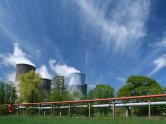Coal Ash Debate Ripples Throughout Utility World
EPA to Decide Soon on Hazardous Waste Classification

The Environmental Protection Agency has a big choice to make: to regulate coal ash as a hazardous waste or to continue to oversee it as a solid waste with some added enforcement. Public comments end this month with a decision expected in December.
While the Obama administration would probably prefer the stricter guidelines, it is unlikely to expend the necessary political capital. With the Republicans now in charge of the House of Representatives, the president's team will extend an olive branch and instead choose to make more incremental changes -- to toughen disposal standards and to let the states maintain their leadership role.
"We are critically concerned that regulating coal combustion byproducts as hazardous waste - an approach opposed by every State (over 20) that has weighed in on the issue - would not only effectively end the beneficial use of these materials, but also would jeopardize the ability of certain of our power plants to remain in service," write the Edison Electric Institute and the American Public Power Association to U.S. senators.
Right now, coal combustion byproducts are categorized as a solid waste. That has allowed those byproducts to participate in a secondary market whereby they can be recycled and used for such things as cement and dry wall. But if the material is reclassified as a hazardous waste, coal groups say it would be irreversibly stigmatized and any ancillary use of them would evaporate.
The investigations into coal ash have been ongoing ever since a retention wall owned and controlled by the Tennessee Valley Authority broke and 5.4 million yards then escaped. So, after examining the issue, the current EPA is likely to modify the rules - not overhaul them -- noting that increasing evidence exists to suggest that mercury-and arsenic-laden coal ash adversely affects human health and the environment.
Coal ash is disposed of either as a liquid that goes into large surface impoundments or as a solid that is placed into landfills. TVA, which had used the liquid disposal method at its Kingston Fossil Plant, now says that it will stop impounding "wet ash." Instead, it will convert it to dry ash and bury it in places with liners while also monitoring the ground water - something to which the EPA says would become mandatory for all such sites.
Right now, EPA says that power plants create annually 136 million tons of coal ash. That number, though, is expected to rise to 175 million tons by 2015. Last year, the regulator released a report saying that 49 coal ash sites were considered a "high hazard," meaning that if an accident occurred it could result in deaths. It identified another 71 sites that it says are responsible for the leakage of heavy metals into ground water.
Intense Lobbying
The TVA coal ash spill is the most prominent. But smaller accidents have occurred before. And statistics gathered by environmental groups indicate that unless the situation is brought under federal control, the risks will climb.
"Before the Kingston disaster, coal ash was a sleeping, toxic giant," says Stephen Smith, executive director of the Southern Alliance for Clean Energy. "This epic event was the catalyst for much needed refocusing on just how dangerous this coal waste is."
If the byproduct would be regulated as a hazardous material, the agency says that would cost industry $1.5 billion a year whereas if it is viewed as a nonhazardous material, it would run $600 million a year. By contrast, TVA is spending at least $1.2 billion to clean up the accident that covers 300 acres -- something that EPA contends might have been prevented if either of its two proposals had been in effect.
Under both approaches, EPA would leave in place an exemption that allows for the beneficial recycling of coal ash -- a huge business that alleviates already stressed landfills and a process that EPA says will keep the public safe. Today, about 54 million tons annually of the material is recycled.
The coal ash industry, however, says that the no mater what, the industry will be tainted. That's unfortunate, it adds, noting that if the material is properly handled, it presents no risk to the public. Moreover, because coal ash is now recycled, it reduces the effects on climate change.
"The stigma of being associated with hazardous wastes is real and is already affecting markets," says Thomas Adams, executive director of the American Coal Ash Association, who spoke at a recent public hearing in Tennessee.
The utility sector says that it has heard the warning shots that have been fired after the collapse of TVA's retention wall. While it is open to having national policymakers close the loopholes in their local rules, companies believe strongly that the states are closer to the issues when it comes to regulating their facilities - sites that they say are up to engineering standards and which are routinely inspected.
After the TVA disaster, conventional wisdom would indicate that it would be easier to more closely regulate the coal ash industry. But such thinking would under-estimate the potency of the utility and coal lobbies. And now, with the Republican surge in Congress, the Obama administration will want to play nicely. Therefore, any sudden move to classify coal combustion byproducts as a hazardous waste is improbable.
Gradual changes, though, are another matter. Industry recognizes that it must take greater precautions to prevent any further coal ash spills - just as TVA has done on its own and in advance of any potential changes in the law. Needless-to-say, the rules will tighten but they won't strangle the secondary recycling markets for coal ash.
EnergyBiz Insider is nominated for Best Online Column by Media Industry News.
So what do you think? Please share your thoughts by posting a quick comment below, or by sending a longer reply to energybizinsider@energycentral.com.